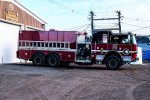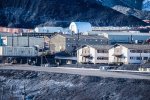That should be an amazing journey!I've been to Antarctica several times, ship and/or air based expeditions, never anything overland. In the Arctica, I have crossed most of the Russian Arctic, Svalbard, Franz Josef Land, Northern Greenland. What I would like ultimately is a vehicular partial-circumnavigation of the frozen continent. Kindly forgive the crude map.
View attachment 703173
You are using an out of date browser. It may not display this or other websites correctly.
You should upgrade or use an alternative browser.
You should upgrade or use an alternative browser.
Antarctica Rigs
- Thread starter Xenobian
- Start date
pith helmet
Well-known member
Nice post. A couple of my good friends worked there in the early 90’s when they were still housed in big army tents. Those old photos looked especially cold. Another friend met his wife there in the early 2000’s. He got to meet Werner Herzog when he visited.
Xenobian
Active member
Thank you. Yes the old pictures always seem to look especially frozen... It was about -25 F (-32 C) when I was there. They've definitely upgraded from army tents nowadays. Werner Herzog is one of my favorite film makers, lucky for your friend. I was thinking about him just the other day when making a post about my recently overland expedition across West Africa, the Sahara in Chad and Central African Republic. One of his great films was Echoes from a Sombre Empire about Emperor Bokassa of the Central African Republic:Nice post. A couple of my good friends worked there in the early 90’s when they were still housed in big army tents. Those old photos looked especially cold. Another friend met his wife there in the early 2000’s. He got to meet Werner Herzog when he visited.

Overland through Niger, Chad, Central African Republic
Apologies again for a second (and last) aviation post, rather than overland. The next stage of the journey was an excursion by air, from Bangui. The destination was very much open ended... The flight was meant to be out to Bakouma, of uranium mine fame, in the east of the C.A.R. I received a...
 expeditionportal.com
expeditionportal.com
pith helmet
Well-known member
What I said. He is one of my favorites as well. I will have to check out that other thread; self supported African adventures are my favorite reads.Werner Herzog is one of my favorite film makers, lucky for your friend.
Mass_Mopar
Don't Litter
Love the photos, I dream about working down there some day for a season or two. What kind of work brought you to the bottom of the planet?
Xenobian
Active member
They're my favorite sort of expedition to undertaken, and my main focus nowWhat I said. He is one of my favorites as well. I will have to check out that other thread; self supported African adventures are my favorite reads.
Xenobian
Active member
Most definitely an interesting place to work, either there or the South Pole base... I wasn't there for work or research, it was a purely private trip.Love the photos, I dream about working down there some day for a season or two. What kind of work brought you to the bottom of the planet?
Xenobian
Active member
Old FIAT at Mario Zucchelli Station (Italy), Terra Nova Bay, Ross Sea - https://en.wikipedia.org/wiki/Zucchelli_Station


keep it coming!
Xenobian
Active member
The Campagnola has sadly seen better days, but I think it's still used for driving around the (small station). I like how the national operators of the polar stations make the effort to go all out with using vehicles (and almost everything else) from their respective countries, even if that requires hyper-modifications that would never be done in any other context, to make it workI agree with Christian...Keep it coming!
Thumbs up for the little Fiat Campagnola!
Xenobian
Active member
There are only so many truck related photos you can take in most of Antarctica, so, instead, Scott's Hut at Cape Evans. It was about -26 F (-32 C).
Scott's Hut is a building located on the north shore of Cape Evans on Ross Island in Antarctica. It was erected in 1911 by the British Antarctic Expedition of 1910–1913 (also known as the Terra Nova Expedition) led by Robert Falcon Scott.
Scott's Hut was prefabricated in England before being brought south by ship. It is rectangular, 15m long and 7.6m wide. Insulation was provided by seaweed sewn into a quilt, placed between double-planked inner and outer walls. The roof was a sandwich of three layers of plank and two layers of rubber ply enclosing more quilted seaweed. Lighting was provided by acetylene gas, and heating came from the kitchen and a supplementary stove using coal as fuel.
The hut had some other uses until it was ultimately abandoned in 1917. Today, it is remarkably well preserved by both the cold and also the efforts of the Antarctic Heritage Trust of New Zealand.
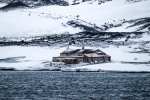

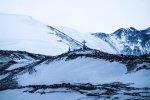


Scott's Hut is a building located on the north shore of Cape Evans on Ross Island in Antarctica. It was erected in 1911 by the British Antarctic Expedition of 1910–1913 (also known as the Terra Nova Expedition) led by Robert Falcon Scott.
Scott's Hut was prefabricated in England before being brought south by ship. It is rectangular, 15m long and 7.6m wide. Insulation was provided by seaweed sewn into a quilt, placed between double-planked inner and outer walls. The roof was a sandwich of three layers of plank and two layers of rubber ply enclosing more quilted seaweed. Lighting was provided by acetylene gas, and heating came from the kitchen and a supplementary stove using coal as fuel.
The hut had some other uses until it was ultimately abandoned in 1917. Today, it is remarkably well preserved by both the cold and also the efforts of the Antarctic Heritage Trust of New Zealand.





Xenobian
Active member
NASA have an active presence in the Dry Valleys. Mars buggies are tested here (the start of Taylor Valley).
Also, NASA do testing of drills designed for sampling on Mars in the permafrost of the driest parts of the valleys, the areas most analogous to the Martian surface. They found no living organisms in the permafrost, the first location on the planet visited by humans with no active microbial life.

To get to the dry valleys, one needs to travel from the ship by helicopter. The flight was around 15 minutes each way and was spectacular to witness this strange and barren landscape.
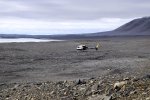


Also, NASA do testing of drills designed for sampling on Mars in the permafrost of the driest parts of the valleys, the areas most analogous to the Martian surface. They found no living organisms in the permafrost, the first location on the planet visited by humans with no active microbial life.

To get to the dry valleys, one needs to travel from the ship by helicopter. The flight was around 15 minutes each way and was spectacular to witness this strange and barren landscape.



Xenobian
Active member
The McMurdo Dry Valleys are a row of snow-free valleys in Antarctica located within Victoria Land west of McMurdo Sound. The Dry Valleys experience extremely low humidity and surrounding mountains prevent the flow of ice from nearby glaciers. The rocks here are granites and gneisses, and glacial tills dot this bedrock landscape, with loose gravel covering the ground.
The region is one of the world's most extreme deserts, and includes many features including Lake Vida, a saline lake, and the Onyx River, a meltwater stream and Antarctica's longest river. Although no living organisms have been found in the permafrost here, endolithic photosynthetic bacteria have been found living in the relatively moist interior of rocks and anaerobic bacteria, with a metabolism based on iron and sulfur, live under the Taylor Glacier.



2,600 yr old mummified seals exist in the Dry Valleys.

The region is one of the world's most extreme deserts, and includes many features including Lake Vida, a saline lake, and the Onyx River, a meltwater stream and Antarctica's longest river. Although no living organisms have been found in the permafrost here, endolithic photosynthetic bacteria have been found living in the relatively moist interior of rocks and anaerobic bacteria, with a metabolism based on iron and sulfur, live under the Taylor Glacier.



2,600 yr old mummified seals exist in the Dry Valleys.

